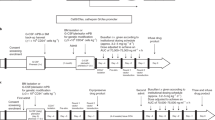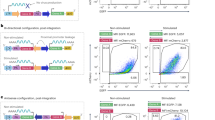Abstract
We have comparatively evaluated the efficiency of a series of retroviral vectors transducing the gp91-phox gene, whose defects are responsible for impaired production of superoxide anion (O2−) by phagocytic cells and lead to the X-linked form of chronic granulomatous disease (X-CGD). These vectors included four constructs based on the MoMuLV backbone and expressing gp91-phox from the viral long terminal repeat (LTR) or from internal promoters, and one construct based on the myelotropic FMEV vector. Expression of the therapeutic gene from the MoMuLV LTR was unsatisfactory after transduction of the PLB985 X-CGD knockout cell line and of primary CD34+ hematopoietic progenitors from X-CGD patients. The presence of either constitutive or inducible internal promoters did not result in important improvements in the efficiency of O2− production and lowered the titers of the viral preparations. In contrast, sustained levels of superoxide generation were obtained upon transduction with the FMEV vector. To analyze the efficiency of transgene expression at the single cell level, over 150 cellular clones were generated from bulk cultures of PLB985 X-CGD cells transduced with this vector, each one representative of an individual transduction event. These clones revealed a markedly heterogeneous pattern of gp91-phox expression, ranging from complete silencing to full restoration of superoxide production. Within each clone, expression of the therapeutic gene correlated with the number of expressing cells rather than with the average levels of expression from each cell, indicating that at the single cell level, the proviral promoter is regulated by a binary, on/off mechanism. Moreover, both transduced bulk and clonal cell populations displayed a tendency to a progressive extinction of expression over time, with a mechanism involving LTR methylation. The design of novel retroviral vectors escaping silencing is highly desirable for efficient gene therapy.
This is a preview of subscription content, access via your institution
Access options
Subscribe to this journal
Receive 12 print issues and online access
$259.00 per year
only $21.58 per issue
Buy this article
- Purchase on Springer Link
- Instant access to full article PDF
Prices may be subject to local taxes which are calculated during checkout







Similar content being viewed by others
References
Dunbar CE . Gene transfer to hematopoietic stem cells: implications for gene therapy of human disease Annu Rev Med 1996 47: 11–20
Bodine DM et al. Long-term in vivo expression of a murine adenosine deaminase gene in rhesus monkey hematopoietic cells of multiple lineages after retroviral mediated gene transfer into CD34+ bone marrow cells Blood 1993 82: 1975–1980
Dunbar CE et al. Retrovirally marked CD34-enriched peripheral blood and bone marrow cells contribute to long-term engraftment after autologous transplantation Blood 1995 85: 3048–3057
Kohn DB . The current status of gene therapy using hematopoietic stem cells Curr Opin Pediatr 1995 7: 56–63
Barranger JA . Haematopoietic stem cell gene transfer GeneTherapy 1996 3: 379–380
Larochelle A et al. Identification of primitive human hematopoietic cells capable of repopulating NOD/SICD mouse bone marrow: implications for gene therapy Nature Med 1996 2: 1329–1336
Malech HL et al. Prolonged production of NADPH oxidase-corrected granulocytes after gene therapy of chronic granulomatous disease Proc Natl Acad Sci USA 1997 94: 12133–12138
Kohn DB et al. T lymphocytes with a normal ADA gene accumulate after transplantation of transduced autologous umbilical cord blood CD34+ cells in ADA-deficient SCID neonates Nature Med 1998 4: 775–780
Roos D . The genetic basis of chronic granulomatous disease Immunol Rev 1994 138: 121–157
Zhen L et al. Gene targeting of X chromosome-linked chronic granulomatous disease locus in a human myeloid leukemia cell line and rescue by expression of recombinant gp91-phox Proc Natl Acad Sci USA 1993 90: 9832–9836
Zentilin L et al. Functional reconstitution of oxidase activity in X-linked chronic granulomatous disease by retrovirus-mediated gene transfer Exp Cell Res 1996 225: 257–267
Morgenstern JP, Land H . Advanced mammalian gene transfer: high titre retroviral vectors with multiple drug selection markers and a complementary helper-free packaging cell line Nucleic Acids Res 1990 18: 3587–3596
The International Chronic Granulomatous Disease Cooperative Study Group . A controlled trial of interferon gamma to prevent infection in chronic granulomatous disease New Engl J Med 1991 324: 509–516
Wong P, Severns CW, Guyer NB, Wright TM . A unique palindromic element mediates gamma interferon induction of mig gene expression Mol Cell Biol 1994 14: 914–922
Tafuro S, Zentilin L, Falaschi A, Giacca M . Rapid retrovirus titration using competitive polymerase chain reaction Gene Therapy 1996 3: 679–684
Bowtell DD, Cory S, Johnson GR, Gonda TJ . Comparison of expression in hemopoietic cells by retroviral vectors carrying two genes J Virol 1988 62: 2464–2473
Roos D et al. X-CGDbase: a database of X-CGD-causing mutations Immunol Today 1996 17: 517–521
Challita PM, Kohn DB . Lack of expression from a retroviral vector after transduction of murine hematopoietic stem cells is associated with methylation in vivo Proc Natl Acad Sci USA 1994 91: 2567–2571
Hildinger M et al. FMEV vectors: both retroviral long terminal repeat and leader are important for high expression in transduced hematopoietic cells Gene Therapy 1998 5: 1575–1579
Baum C et al. Novel retroviral vectors for efficient expression of the multidrug resistance (mdr-1) gene in early hematopoietic cells J Virol 1995 691: 7541–7547
Giacca M et al. Fine mapping of a replication origin of human DNA Proc Natl Acad Sci USA 1994 91: 7119–7123
Bird A . The essentials of DNA methylation Cell 1992 70: 5–8
Ding C et al. High-level reconstitution of respiratory burst activity in a human X-linked chronic granulomatous disease (X-CGD) cell line and correction of murine X-CGD bone marrow cells by retroviral-mediated gene transfer of human gp91phox Blood 1996 88: 1834–1840
Linney E et al. Non-function of a Moloney murine leukaemia virus regulatory sequence in F9 embryonal carcinoma cells Nature 1984 308: 470–472
Grez M, Zornig M, Nowock J, Ziegler M . A single point mutation activates the Moloney murine leukemia virus long terminal repeat in embryonal stem cells J Virol 1991 65: 4691–4698
Robbins PB et al. Increased probability of expression from modified retroviral vectors in embryonal stem cells and embryonal carcinoma cells J Virol 1997 71: 9466–9474
Wang L, Robbins PB, Carbonaro DA, Kohn DB . High-resolution analysis of cytosine methylation in the 5 long terminal repeat of retroviral vectors Hum Gene Ther 1998 9: 2321–2330
Emerman M, Temin HM . Genes with promoters in retrovirus vectors can be independently suppressed by an epigenetic mechanism Cell 1984 39: 449–467
Emerman M, Temin HM . Quantitative analysis of gene suppression in integrated retrovirus vectors Mol Cell Biol 1986 6: 792–800
Byun J et al. Analysis of the relative level of gene expression from different retroviral vectors used for gene therapy Gene Therapy 1996 3: 780–788
Hatzoglou M, Bosch F, Park EA, Hanson RW . Hormonal control of interacting promoters introduced into cells by retroviruses J Biol Chem 1991 266: 8416–8425
Vile R, Miller N, Chernajovsky Y, Hart I . A comparison of the properties of different retroviral vectors containing the murine tyrosinase promoter to achieve transcriptionally targeted expression of the HSVtk or IL-2 genes Gene Therapy 1994 1: 307–316
Byun J, Kim JM, Robbins PD, Kim S . The selectable marker neo gene down-regulates gene expression from retroviral vectors containing an internal ribosome entry site Gene Therapy 1998 5: 1441–1444
Seliger B, Killian M, Pfizenmaier K . Distinct mechanisms of interferon-gamma and tumor necrosis factor-alpha action in oncogene-transformed mouse fibroblasts J Cell Biochem 1988 38: 205–212
Ghazizadeh S, Carroll JM, Taichman LB . Repression of retrovirus-mediated transgene expression by interferons: implications for gene therapy J Virol 1997 71: 9163–9169
Pawliuk R, Eaves CJ, Humphries RK . Sustained high-level reconstitution of the hematopoietic system by preselected hematopoietic cells expressing a transduced cell-surface antigen Hum Gene Ther 1997 8: 1595–1604
Baum C et al. The potent enhancer activity of the polycythemic strain of spleen focus-forming virus in hematopoietic cells is governed by a binding site for Sp1 in the upstream control region and by a unique enhancer core motif, creating an exclusive target for PEBP/CBF J Virol 1997 71: 6323–6331
Petersen R, Kempler G, Barklis E . A stem cell-specific silencer in the primer-binding site of a retrovirus Mol Cell Biol 1991 11: 1214–1221
Walters MC et al. Enhancers increase the probability but not the level of gene expression Proc Natl Acad Sci USA 1995 92: 7125–7129
Walters MC et al. Transcriptional enhancers act in cis to suppress position-effect variegation Genes Dev 1996 10: 185–195
Laker C et al. Host cis-mediated extinction of a retrovirus permissive for expression in embryonal stem cells during differentiation J Virol 1998 72: 339–348
Robbins PB et al. Consistent, persistent expression from modified retroviral vectors in murine hematopoietic stem cells Proc Natl Acad Sci USA 1998 95: 10182–10187
Jones PL et al. Methylated DNA and MeCP2 recruit histone deacetylase to repress transcription Nat Genet 1998 19: 187–191
Nan X et al. Transcriptional repression by the methyl-CpG-binding protein MeCP2 involves a histone deacetylase complex Nature 1998 393: 386–389
Gautsch JW, Wilson MC . Delayed de novo methylation in teratocarcinoma suggests additional tissue-specific mechanisms for controlling gene expression Nature 1983 301: 32–37
Niwa O, Yokota Y, Ishida H, Sugahara T . Independent mechanisms involved in suppression of the Moloney leukemia virus genome during differentiation of murine teratocarcinoma cells Cell 1983 32: 1105–1113
Becker S et al. Correction of respiratory burst activity in X-linked chronic granulomatous cells to therapeutically relevant levels after gene transfer into bone marrow CD34+ cells Hum Gene Ther 1998 9: 1561–1570
Schilz AJ et al. High efficiency gene transfer to human hematopoietic SCID-repopulating cells under serum-free conditions Blood 1998 92: 3163–3171
Tucker KA, Lilly MB, Heck L Jr, Rado TA . Characterization of a new human diploid myeloid leukemia cell line (PLB- 985) with granulocytic and monocytic differentiating capacity Blood 1987 70: 372–378
Sambrook J, Fritsch E, Maniatis T . Molecular Cloning – A Laboratory Manual Cold Spring Harbor Laboratory Press: Cold Spring Harbor 1989
Diviacco S et al. A novel procedure for quantitative polymerase chain reaction by coamplification of competitive templates Gene 1992 122: 3013–3020
Kume A, Dinauer MC . Retrovirus-mediated reconstitution of respiratory burst activity in X-linked chronic granulomatous disease cells Blood 1994 84: 3311–3316
Porter CD et al. Superoxide production by normal and chronic granulomatous disease (CGD) patient-derived EBV-transformed B-cell lines measured by chemiluminescence-based assays J Immunol Meth 1992 155: 151–157
Metcalf D . In vitro cloning techniques for hemopoietic cells: clinical applications Ann Intern Med 1977 87: 483–488
Akgun E, Ziegler M, Grez M . Determinants of retrovirus gene expression in embryonal carcinoma cells J Virol 1991 65: 382–388
Acknowledgements
This work was supported by grant A.104 of Telethon Italy to MG and by a grant from the Children Hospital ‘Burlo Garofolo’, Trieste, Italy. We thank Dr S Seeber for plasmid pSF2n We are very grateful to Dr Hung Fang and the members of the Giacca laboratory for critical reading of the manuscript.
Author information
Authors and Affiliations
Rights and permissions
About this article
Cite this article
Zentilin, L., Qin, G., Tafuro, S. et al. Variegation of retroviral vector gene expression in myeloid cells. Gene Ther 7, 153–166 (2000). https://doi.org/10.1038/sj.gt.3301057
Received:
Accepted:
Published:
Issue Date:
DOI: https://doi.org/10.1038/sj.gt.3301057
Keywords
This article is cited by
-
Alpharetroviral Vector-mediated Gene Therapy for X-CGD: Functional Correction and Lack of Aberrant Splicing
Molecular Therapy (2013)
-
Alpharetroviral Self-inactivating Vectors: Long-term Transgene Expression in Murine Hematopoietic Cells and Low Genotoxicity
Molecular Therapy (2012)
-
Physiological regulation of transgene expression by a lentiviral vector containing the A2UCOE linked to a myeloid promoter
Gene Therapy (2012)
-
Lentiviral Vector Design and Imaging Approaches to Visualize the Early Stages of Cellular Reprogramming
Molecular Therapy (2011)
-
Efficient In Vivo Targeting of Epidermal Stem Cells by Early Gestational Intraamniotic Injection of Lentiviral Vector Driven by the Keratin 5 Promoter
Molecular Therapy (2008)



